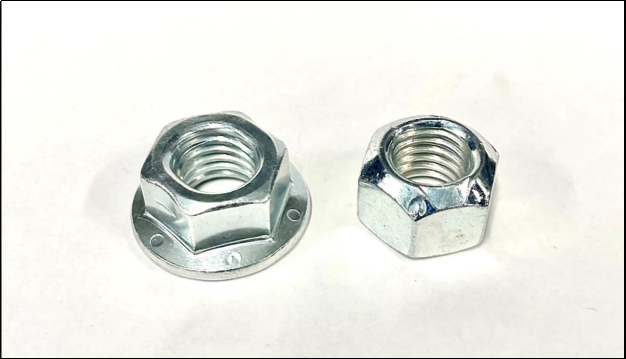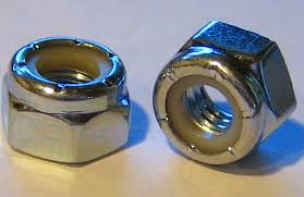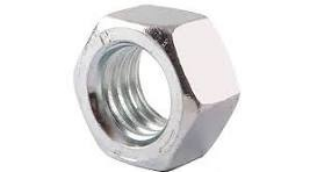Lock Nut vs Hex Nut: A Complete Comparing Guide
 Sep 12,2025
Sep 12,2025

Let us tell you that in the world of fastening and joining, these nuts are an important part of the applications. This article is focused on the two specific types of nuts, i.e. Lock Nut and Hex Nut. For comprehensive information, this article discusses the types of these nuts, materials for manufacturing and applications, etc. So, let's start then:

What Is a Lock Nut?
You can see a lock nut in the following figure:

It is a type of nut, but more special than other types. These nuts are especially designed for tough conditions, such as resisting loosening during vibration or torque. The lock nut comes with a lock and can easily rotate during fastening or loosening the assembly.
How Lock Nuts Resist Loosening
Let us tell you about the issue of why loosening occurs first. During applications, when vibrations or dynamic loads or thermal cycles start, conventional nuts start loosening. It is an important issue for engineers because loosening causes disassembly in the applications, which ultimately causes failures.
To avoid such risks, Lock Nuts are especially designed which use locking mechanisms to keep the assembly firmly secure even in challenging conditions. The mechanism includes a slight deformation to grip the bolt or increasing the friction on the threads.
Lock Nut Pros
For engineers, these lock nuts are very helpful because they make strategies easier to resist against fasteners loosening:
- In applications where thermal cycles are dominant and can cause loosening of the assembly
- During dynamic loads
- In chemical environments, lock nuts fight corrosion and rust well.
Due to their high durability, lock nuts can be used multiple times
Lock Nut Limits
But there are some cases in which engineers do not prefer to use lock nuts, such as:
Nylon insertions melt and degrade at high temperatures
If the nuts are serrated, they can damage soft surfaces such as an aluminium surface.
Common Lock Nut Types
Table 1: Nylon Insert Lock Nut vs All-metal Lock Nut
|
Nylon Insert Lock Nut |
All-Metal Lock Nut |
|
Excellent vibration resistance. Limited temperature range. Not for multiple reuses. |
High temperature capability. Good reusability. Strong vibration resistance. |
- Serrated Flange
This is a type of lock nut which combines a nut with the serated washer surface. This method helps engineers against the rotation of nuts because of biting into the surface.
- Jam Nut
As the name shows, it is used for creating a jam aganist the movement of nuts. Simply, it is used with a nut to stop it from moving by jamming its way.
What Is a Hex Nut?
Due to its hexagonal shape, this type of nut is called a hex nut, as it is shown in the following figure:

It is a through-hole part with internal threads for fastening the bolts. The internal threads grip the bolt threads to make a strong assembly of parts.
What Can A Standard Hex Nut Do?
Engineers use a standard Hex Nut for making joints in an assembly of multiple components. As mentioned earlier, the internal threads of a hex nut play a crucial role in making joints. The internal threads of a hex nut grip one or more than one bolts to make joints.
How Hex Nuts Stay Tight
The tightness or loosening of the hex nuts depends on how much strength these nuts are turned over the bolt. Secondly, engineers often use adhesive materials or sometimes a double nut.
Hex Nut's Limits under Vibration
A standard hex nut cannot be used where dynamic fluctuating loads or thermal cycles are present.
In case of no alternatives, you can use a hex nut in vibrations, but you will need some extra materials such as a lock-washer or thread-locking adhesive, etc.
Lock Nut vs Hex Nut: Key Differences
Let us make this article more informative by comprehensively figuring out some major differences between a lock nut and a hex nut.
1. Primary Function
Table 2: Primary Function in a Hex nut and a Lock nut
|
Feature |
Hex Nut |
Lock Nut |
|
Core Purpose |
To create a standard, non-permanent fastener joint. |
To secure a bolted connection and resist loosening. |
|
Key Trait |
Provides clamping force when torqued. |
Provides clamping force plus a prevailing locking action. |
2. Locking Mechanism
Table 3: Locking mechanism of a Hex nut vs a Lock nut
|
Hex Nut |
Lock Nut |
|
Relies solely on bolt tension and friction. |
Uses a manufactured feature (e.g., nylon insert, deformed threads). |
|
Fully reusable without performance loss. |
Limited reusability; locking feature degrades with repeated use. |
3. Service Limits
Table 3: Service Limits of a Hex nut vs a Lock nut
|
Feature |
Hex Nut |
Lock Nut |
|
Vibration Resistance |
Poor; prone to loosening under dynamic loads. |
Excellent; designed to maintain hold in high-vibration environments. |
|
Temperature Range |
Unlimited; suitable for all temperatures. |
Limited by its locking element (e.g., nylon insert has a max temp). |
Lock Nut vs Hex Nut: Use Cases by Industry
Let us show you in this section of the article how different industries use a lock nut and a hex in different applications.
Automotive Powertrain
Hex nuts are very common in automotive powertrains and are used for making joints. The most important applications include:
- Engine components
- Exhaust systems
- Brake assemblies
Lock nuts are also used in automotive powertrains, such as:
- In shock absorbers in suspension systems
- Brake callipers and rotors
- In wheel hubs during the wheel assembly
Rotating Machinery
Locking nuts are very useful in rotating machinery components because of their resistance to dynamic loads and vibrations. These nuts are used in:
- Bearings
- Gears
- Pulleys onto a shaft
- Wheel axles
While hex nuts are more commonly used in rotating machinery than lock nuts for temporary fastening. You can find its applications in:
- Engine pumps
- Motors
- Conveyors
Electrical Panels
You will see engineers using lock nuts for many applications in electric panels, such as:
- cable glands
- Mounting of switches or breakers
- To connect the electrical conduit to the panel knockouts
While engineers use hex nuts to:
- Fasten fasten terminal blocks
- Mount brackets and frames inside the enclosure
- Burbar joints for good electrical connection
Structural Steelwork
As you know, structural steelwork is everywhere around us, so you will commonly find these nuts being used.
For instance, hex nuts are used in:
- Beams, columns and scaffolding in buildings and bridges
- Streetlights
While lock nuts are used in:
- Turbine towers
- Building frames
- To secure the components of heavy machinery, cranes, etc.
Lock Nut vs Hex Nut: Machining Materials
The materials play a critical role in the performance of the lock and hex nuts. This section discusses common materials used for the lock and hex nuts.
Carbon Steel
Carbon steel is known for its high strength. This material for the lock and hex nuts is used when corrosion is not the issue. Carbon steel lock and hex nuts are used in non-critical applications, such as in washing machines or in furniture, etc.
Stainless Steel
Generally, engineers prefer stainless steel for the lock and hex nuts because this material is reliable in case of high-load situations or when exposed to thermal stress. For instance, in rail channels, stainless steel lock and hex nuts remain stable during loads.
Stainless Steel 304
This grade of stainless steel is known for food processing equipment due to good corrosion resistance, which is why stainless steel 304 locks and hex nuts are often employed in milk or other food-related equipment.
Stainless Steel 316
Stainless steel 316 is known for its exceptional corrosion resistance among all stainless steel grades. This is the primary reason why engineers employ stainless steel 316 locks and hex nuts in chemical plants where chloride-rich environments are present.
Plated Steel
The lock and hex nuts of plated steel (e.g. Zn-Coated steel) are commonly used in streetlights. The sacrificial layer of Zn provides resistance against moisture to prevent rust and corrosion.
Brass
Brass offers multiple advantages over other materials for lock and hex nuts. The primary advantages include electrical and thermal conductivities. Brass lock and hex nuts also provide corrosion and tarnish resistance, which is why they are used in electrical and communication systems.
How to Design for Your Joint Project
This section is a guideline for engineers that how they can choose between a lock nut and a hex nut. There are some factors which decide the selection of a certain type of nut.
1. Vibration Level
The first and most important factor for a specific nut selection is the vibration level. For dynamic loads or high vibrations, lock nuts are more suitable.
Hex nuts are more useful in simple conditions rather than lock nuts.
2. Service Temperature
Engineers must know the temperature of the environment where the nuts have to be used. At high temperatures under-hood, nylon lock nuts cannot be used because nylon inserts melt at that temperature. In such conditions, engineers should use all-metal nuts.
3. Maintenance Plan
Do not assemble or disassemble the joints repeatedly because it affects the nuts' performance. For repeated assembly and disassembly, use hex nuts with locking aids because these nuts maintain their strength even after continuous assembly or disassembly.
4. Cost Target
The cost of the nuts for a project depends on the type of nuts to be used, such as standard or customised. Customised nuts are often expensive than standard nuts. But you don't need to be worried about the cost when TUOFA Precision one-stop custom machining is here. TUOFA stands tall with the most advanced machines and expert operators and technicians. TUOFA will provide you with customised nut machining solutions at the best rates and fast delivery times.
What Is An Alternative to Lock Nuts?
Let's figure out, as an engineer, which alternatives you have other than the lock nuts.
Lock Nut VS Lock Washer
As compared to a lock nut, a lock washer fastens two components by either using sharp teeth that dig into the material or spring tension. The primary advantages of lock washers over lock nuts include cost-effectiveness, compatibility with hex nuts, easily replaceable, but cannot overtake lock nuts in high-vibration applications.
Lock Nut vs Threadlocker
A threadlocker is different from a lock nut. It is an aerobic adhesive used for bolts, nuts, etc. To remain tight during vibrations. It shows advantages over lock nuts in case of tight spaces, lightweight, but difficult to remove later, and requires a curing time.
Double-Nut Method
It is quite a different method from other fastening methods. In this method, engineers use two nuts on top of each other. This method serves two purposes. Sometimes this method is used to strengthen the joint because both nuts jam together. Secondly, this method is used for removing the stubborn bolt because when both nuts create a tool for leverage.
Wedge Lock Washer
It is another unique method to strengthen the joints. It is a two-piece mechanical locking system that holds the joints by tension force instead of friction.

Lock Nut Solutions: Comparing Guide
This section shows a comparison of lock nuts with other types of nuts for a better understanding of lock nuts.
Lock Nut VS Castle Nut / Slotted Nut
A castle nut comes with a cotter pin, which helps it resist shear forces. It's one disadvantage, you can say, is that it is slower to assemble than a lock nut. The cotter pin helps to resist loosening when shear forces are applied.
Jam Nut VS Lock Nut
A jam nut is a hexagonal-shaped nut which is half the size of a standard nut. It is used with another nut and works as a jam for the second nut to resist loosening.
Jam Nut VS Hex Nut
A jam nut is thinner than a hex nut and is mainly used for adjusting or supporting the other nut.
Lock Nut VS Flange Nut
A flange nut is a part of a washer which is built-in and used for spreading the load uniformly. But as you know, the lock nut is used to resist the vibrations.
Lock Nut and Custom Solutions
In this section, you can study how we can customise the lock nuts efficiently.
How to Get a Custom Solution?
First, you should know the requirements, like the tolerance, etc. For the customisation. second, you should know whether the material is capable of customisation. And lastly, you need to find an expert to modify the design of the lock nut.
Benefits of Custom Lock Nut Solutions in TUOFA
TUOFA, a Chinese-based company, is one of the best companies for customised precision machining. Due to high expertise and advanced machinery, customisation is done at faster rates.
Flexible Design
We can meet the tight tolerances in the design, which leads to perfection in applications.
Various Material Choices
The multiple materials, including steel, steel alloys, stainless steel, etc., can be customised for lock nuts
Professional Engineering Advice
We can be your good partner by helping you in choosing the right material, tolerances and cost-effective methods.
Conclusion
A lock nut and a hex nut are important parts in the assembly and disassembly of the parts. These nuts ensure resistance against loosening due to vibrations and temporary joints, respectively, in the applications. Engineers can use different alternatives of lock nuts or hex nuts, but it ultimately depends on the requirements of the application. Different methods, such as the wedge lock washer method, are used for strengthening the joints.
FAQs
What is the difference between keps nuts and regular hex nuts?
Keps nut is a lock nut but with a free-spinning washer. It combines two fasteners for easier assembly and vibration resistance. A hex nut is a hexagonal-shaped nut, used for temporary joints.
Can a lock washer replace a lock nut?
No, because a lock washer has its different locking method and reliability than a lock nut.
 Tel/WeChat:
Tel/WeChat:  Email:
Email: 
 Home
Home
 What Is Breaking Strength? Something You Must Know!
What Is Breaking Strength? Something You Must Know! 







